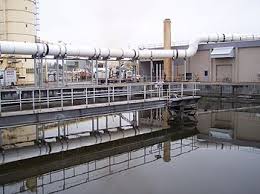The North Bay Wastewater Treatment Plant is a conventional activated sludge facility using biological oxidation, anaerobic sludge digestion and centrifugation sludge dewatering. The plant treats urban wastewater and discharges the processed water in Lake Nipissing.
The treatment plant provides primary treatment followed by conventional activated sludge secondary treatment. The treatment processes include raw wastewater pumping grit removal, commination of course solids, primary settling aeration, phosphorus removal and final clarification.
Before being discharged into Lake Nipissing, the final effluent leaving the plant is chlorinated on a continuous chlorination program in order to protect fish spawning grounds and ensure the safety of the beaches during the appropriate seasons.
The sludge, solid material produced through primary settlement and the "activated sludge process" (the biological secondary treatment process) is stabilized through a two-stage anaerobic digestion that reduces its organic and pathogenic content and renders it nonputrescible. Dewatered sludge (with an approximate solids concentration of 20%) is hauled from the Wastewater Treatment Plant and utilized at the Marsh Drive Landfill Site as topping material, part of the landfill site closure which has been ongoing for several years. Sludge is also hauled to the Merrick Landfill Site as sections are closed and again used as a toping material.
Methane gas formed as a by-product of the sludge digestion process is utilized as the primary fuel for the hot water boilers heating the Treatment Plant. If insufficient methane gas is process, the dual fuel boilers utilizes natural gas. If there is excess methane gas it is flared on site.
The process is monitored and assessed on a daily basis for efficiency and is reported for compliance.
Wastewater Annual Report
